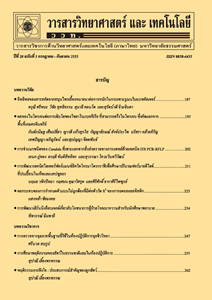ผลของกากเม่าต่อค่าโลหิตวิทยาบางประการและประชากรจุลินทรีย์ในไส้ติ่งของไก่เนื้อ
Main Article Content
Abstract
The objective of this study was to evaluate the effects of mao pomace on some blood variables and cecal microflora of broiler chickens. A total of four-hundred and 7-days Cobb male broiler chickens were randomly assigned to 4 groups with 5 replicates of 20 birds each and fed diets supplemented with 0, 0.5, 1.0 and 1.5 % mao pomace until 42 days old. The results shows that malic acid, tartaric acid and citric acids in mao pomace and feed supplemented with mao pomace 0, 0.5, 1.0 and 1.5 % were not different among groups (P > 0.05). At 42 days old, 5 birds per group were to determine the effect of organic acids in mao pomace on cecal microflora of broiler chickens. Broilers fed dietary mao pomace at 1.0 and 1.5 % (P > 0.05) but there was difference in the broilers fed dietary mao pomace at .0.5 % (P > 0.05). The dietary organic acid in mao pomace supplementation at 0 and 0.5 % significantly increase numbers of Lactobacillus in caecum (P > 0.05). There were no significant differences in numbers of E. coli among the dietary treatments (P > 0.05). Supplementing the diet with organic acids in mao pomace at 0.5, 1.0 and 1.5 % significantly decrese H/L ratio when compared with 0 % organic acid in mao pomace group (P < 0.05). In conclusion, mao pomace can be used as feed additive of broiler chickens to improved microflora balance and decreased H/L ratio.
Keywords: organic acid; mao pomace; H/L ratio
Article Details
References
[2] เยาวมาลย์ ค้าเจริญ และสาโรช ค้าเจริญ, 2548, การพัฒนาผลิตภัณฑ์สมุนไพรสู่การใช้ในเชิงอุตสาหกรรม, น.สัตว์บก 13(146): 105-110.
[3] โอภาส บุญเส็ง, 2550, ไวน์มะเม่าที่สังขละบุรี, น.เทคโนโลยีชาวบ้าน 80(2): 103-107.
[4] กานดา ล้อแก้วมณี และสุดาทิพย์ แสนสุภา, 2558, คุณค่าทางโภชนาการของกากเม่า, ว.วิทยาศาสตร์เกษตร 46(พิเศษ 3): 569-572.
[5] Gross, W.B. and Siegel, P.B., 1986. Effect of initial and second periods of fasting on heterophil/lymphocyte ratios and BW, Avian Dis. 30: 345-346.
[6] McFarlane, J.M. and Curtis, S.E., 1989, Multiple concurrent stressors in chickens, 3: Effects on plasma corticosterone and the heterophil:lymphocyte ratio, Poult. Sci. 68: 522-527.
[7] ชลธิชา นิวาสประกฤติ, ปิยานี รัตนชํานอง, อรทัย อร่ามพงษ์พันธ์ และทักษิณ อาชวาคม, 2555, การวิเคราะห์ปริมาณกรดอินทรีย์ในผลตะค้อจากจังหวัดต่าง ๆ ในภาคตะวันออกเฉียงเหนือของไทยด้วยเทคนิคโครมาโทกราฟีชนิดของเหลวประสิทธิภาพสูง, การประชุมวิชาการแห่งชาติ ครั้งที่ 9, มหาวิทยาลัยเกษตรศาสตร์ วิทยาเขตกำแพงแสน, นครปฐม.
[8] SAS Institute, 2002, SAS User’s Guide, Version 9.0 Ed., SAS Institute Inc., Cary, NC.
[9] ดนุพล สุพรรณวงษ์, อุไร นนท์อาษา, เสมอใจ บุรีนอก, ไกรสิทธิ วสุเพ็ญ, ศศิพันธ์ วงสุทธาวาส, ปราโมทย์ แพงคำ, ฉลอง วชิราภาภร, เมธา วรรณพัฒน์ และเฉลิมพล เยื้องกลาง, 2555, ผลของการเสริมกากเม่าต่อปริมาณการกินได้และการย่อยได้ของโภชนะในแพะ, แก่นเกษตร (พิเศษ 2): 223-229.
[10] ธนภูมิ บุญมี, 2554, ผลของแหล่งคาร์โบไฮเดรตและระดับของกากเม่าสดต่ออัตราการเจริญเติบโต ประสิทธิภาพการย่อยได้ คุณภาพซาก องค์ประกอบของคุณภาพเนื้อและกรดไขมันในเนื้อสุกรหย่านมพันธุ์กระโดน, วิทยานิพนธ์ปริญญาโท, มหาวิทยาลัยเทคโนโลยีราชมงคลอีสาน วิทยาเขตสกลนคร, สกลนคร.
[11] Vasupen, K., Yuangklang, C., Michonathai, J., Wongsuthavas, S., Kesorn, P., Traiyakun, S., Bureenok, S. and Benynen, A.C., 2011, Effects of supplemented fresh mao pomace and organic acids on growth performance of native (Kadon) pigs, pp. 834-836, The 3rd International Conference on Sustainable Animal Agriculture for Developing Countries, Nakon Ratchasima.
[12] พรพรรณ รัตนนาคินทร์, 2540, อินทรีย์เคมี, ภาควิชาเคมี คณะวิทยาศาสตร์ มหาวิทยาลัยแม่โจ้, เชียงใหม่, 229 น.
[13] กานดา ล้อแก้วมณี, อัญชัน ไตรธิเลน และนฤทธิ์ อุดมวงค์, 2559, ผลการเสริมกากเม่าจากน้ำคั้นสดในอาหารต่อสมรรถภาพการผลิตและค่าโลหิตวิทยาบางประการของไก่ไข่, แก่นเกษตร 44(พิเศษ 1): 413-418.
[14] Risley, C.R., Kornegay, E.T., Lindeman, M.D., Wood, C.M. and Eigel, W.M., 1992, Effect of feeding organic acid on selected intestinal content measurement at various time post weaning pig, J. Anim. Sci. 70: 196-206.
[15] Ravindran, V. and Kornegay, E.T., 1993, Acidification of weaned pig diets: A review, J. Sci. Food Agric. 62: 313-322.
[16] อัจฉรา นิยมเดชา, 2559, การใช้กรดอินทรีย์ต่อการยับยั้งการเจริญของแบคทีเรียกลุ่มก่อโรค (ซัลโมเนลล่า) ในทางเดินอาหารของสัตว์ปีก, ว.เกษตร 32(1): 139-149.
[17] Puangpronpitag, D., Areejitranusorn, P. Boonsiri, P. Suttajit, M. and Yongvanit, P., 2008, Antioxidant activities of polyphenolic compounds isolated from Antidesma thwaitesianum Müll. Arg. seeds and marcs, J. Food Sci. 73: 648-653.
[18] Nuengchamnong, N. and Ingkaninan, K., 2010, On-line HPLC-MS-DPPH assay for the analysis of phenolic antioxidant compounds in fruit wine: Antidesma thwaitesianum Müll, Food Chem. 118: 147-152.
[19] Puangpronpitag, D., Yongvanit, P., Boonsiri, P., Suttajit, M. Areejitranusorn, P. and Na, H.K., 2011, Molecular mechanism under-lying anti-inflamatory effects of Maomao (Antidesma thwaitesianum Müll. Arg.) polyphenolics in human breast epithelial
cells, Food Chem. 127: 1450-1458.
[20] Attia, G., El-Eraky, W., Hassanein, E., El-Gamal, M., Farahat, M. and Hernandez-Santana, A., 2017, Effect of dietary inclusion of a plant extract blend on broiler growth performance, nutrient digestibility, caecal microflora and intestinal histomorphology, Int.J. Poult. Sci. 16: 344-353.
[21] Apajalahti, J., Kettunen, A. and Graham, H., 2004, Characteristics of the gastro-intestinal microbial communities, with special reference to the chicken, World Poult. Sci. J. 60: 223-232.
[22] Rolfe, R.D., 2000, The role of probiotic cultures in the control of gastrointestinal health, J. Nutr. 130: 396S-402S.
[23] สุทิสา เข็มผะกา, 2556, ผลการเสริมกรดอินทรีย์ต่อสุขภาพทางเดินอาหารและสมรรถนะการผลิตของลูกสุกรหย่านม, มหาวิทยาลัยสุรนารี, นครราชสีมา.
[24] ชัยวัฒน์ สุวรรณทัต, สุวรรณา กิจภาภรณ์, กฤษ อัคนาพร, พิภพ สดสี และนันทวัน บุญยะประภัศร, 2547, การใช้ขมิ้นชันเป็นสารต้านออกซิเดชั่นต่อสถานภาพภูมิคุ้มกันและสมรรถภาพการเจริญเติบโตของไก่เนื้อซึ่งอยู่ในสภาวะเครียด, น. 181, ใน สมุนไพรไทย : โอกาสและทางเลือกในอุตสาหกรรมการผลิตสัตว์, โรงแรมสยามซิตี้, กรุงเทพฯ.
[25] Jain, N.C., 1993, Essential of Veterinary Hematology, 1st Ed., Philadelphia, USA.

